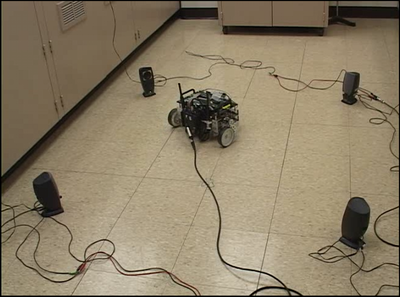Trilateration in Robotic Sensing using Acoustic Experimental Setup
<sidebar>Trilateration_in_Robotic_Sensing_using_Acoustic_Sensors_Nav</sidebar>
Experimental Setup
Our four speakers were placed in a 4ft x 4ft square pattern and the device we wanted to locate, a mobile robot, was set down inside of that circle. The robot was moved about the test area as we watched the computer update where we estimated its position to be.
The speakers were standard computer speakers capable of up to at least 20 Hz to 20kHz.
The microphone was also capable of that frequency range.
The input and output signals were drive by 2 National Instruments ELVIS boards, which acted as Analog to Digital and Digital to Analog converters. These sent signals to the speakers and read the signal from the microphone.
Other than that, all computation, filtering, etc, was done on the computer using National Instruments LabView software.
